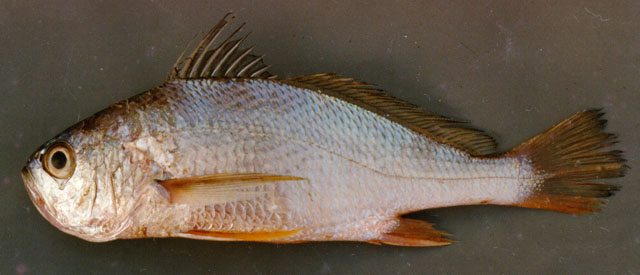
|
Larimus breviceps Cuvier, 1830 Shorthead drum |
||
| Pescada boca mole, Barriguda, Boca de velho, Boca-mole, Boca-torta, Cabeça-dura-relógio, Camanguá, Canganguá, Cangoá, Canguaguá, Congoá, Murucaia, Obeba, Obeva, Oveva, Pescada boca-torta, Pirocaia, Pirocaia-branca, Pirucaia, Purucaia-ubeba, Quindunde, Ubeba, Uveva | ||

|
|
photo by
Vianna, M. |
| Family: | Sciaenidae (Drums or croakers) | |||
| Max. size: | 31 cm TL (male/unsexed); max.weight: 500.0 g | |||
| Environment: | demersal; brackish; marine; depth range 1 - 60 m | |||
| Distribution: | Western Atlantic: Antilles and Costa Rica to Rio de Janeiro, Brazil. Also Honduras (Ref. 26938). | |||
| Diagnosis: | Dorsal spines (total): 11-11; Dorsal soft rays (total): 24-26; Anal spines: 2-2; Anal soft rays: 7-8. Colour silvery grey, darker above. A dark spot at bases of pectoral fins. Pelvic and anal fins often yellowish. A medium-sized to small fish, short and robust. Mouth very large, strongly oblique, lower jaw projecting. Teeth very small and sharp, set in 1 or 2 rows along edges of jaws. Chin without barbels, but with 4 minute pores. Snout with 5 marginal pores, no rostral pores. Gas bladder with a pair of small, horn-like anterior appendages. Sagitta (large earstone) thick and short (Ref 51721). | |||
| Biology: | Inhabits coastal waters, usually found over mud and sandy mud bottoms (Ref. 3702). Also in estuaries (Ref. 3702). Important food fish. | |||
| IUCN Red List Status: | Least Concern (LC); Date assessed: 09 October 2019 Ref. (130435) | |||
| Threat to humans: | harmless | |||
| Country info: | Caught by shrimp trawl in Pirambu, Sergipe (Ref. 118626). Also Refs. 26340, 122009. | |||